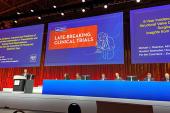New Durability Definitions Still Give Self-Expanding TAVI an Edge vs SAVR
The study has implications for surgical practice as well as TAVI, especially as it expands to younger patients, experts say.

WASHINGTON, DC—Bioprosthetic valve performance appears better following TAVI with a self-expanding, supra-annular device (Medtronic) compared with surgery through 5 years in patients with severe symptomatic aortic stenosis at intermediate and high surgical risk, according to new data from the CoreValve US Pivotal and SURTAVI trials.
The findings expand upon what was presented last year showing that structural valve deterioration (SVD) is more common with surgery compared with these same transcatheter valves, in the same cohort, but the new analysis broadens the definition to VARC-3- and EAPCI-defined bioprosthetic valve dysfunction (BVD). This includes:
- SVD: mean gradient increase ≥ 10 mm Hg from discharge /30-day to last echo and ≥ 20 mm Hg at last echo or new onset/increase of at least moderate intraprosthetic aortic regurgitation
- Non-SVD: severe patient-prosthesis mismatch (PPM) at 30 days/discharge or severe paravalvular regurgitation (PVL) through 5 years
- Thrombosis
- Endocarditis
“Long-term valve performance should be a key consideration in the selection of the first bioprosthesis, especially in younger, lower-risk patients,” said Steven Yakubov, MD (Riverside Methodist, Ohio Health, Columbus), who presented the data Monday during a late-breaking clinical trial session at CRT 2023. “This BVD analysis shows that CoreValve Evolut supra-annular self-expanding bioprosthesis is the only transcatheter valve that demonstrates superior valve performance at 5 years compared to surgery in a randomized clinical trial.”
To TCTMD, Yakubov highlighted that his group “looked at all aspects of BVD as defined by VARC-3 and EAPCI documents. Those had not previously all been looked at,” he said. “[We’re] trying to educate everybody that there is more than just a change in difference in gradients—it is important to all of those things to translate into better clinical outcomes if you have no BVD.”
As of yet, Yakubov continued, this has only been shown with the CoreValve/Evolut valves, although data from the PARTNER trials show similar rates of VARC-3-defined SVD with the Sapien 3 but not Sapien XT device (Edwards Lifesciences) compared with surgical valves at 5 years. “The burden is on all the other valves to show that they can make the same impact that a supra-annular self-expanding valve can make,” he said.
Following the presentation, session co-moderator Gregg Stone, MD (Icahn School of Medicine at Mount Sinai, New York, NY), commented that the rate of BVD observed especially following surgery was unexpectedly high. “A lot of people would be very surprised that, as defined, there was a 14% incidence of bioprosthetic valve dysfunction 5 years after surgery—14%, that’s one out of seven,” he said. What’s more, while as many as two-thirds of these events occur within 30 days, the rest accrued later, Stone noted. “It looks like there would almost be two mechanisms; something that's going on early and something that's going on late.”
Yakubov suggested that the early events were mostly related to SVD. “That's a reflection of PPM,” he said, explaining that this was measured by echo at discharge or 30 days, although not every patient had these data. “It's amazing that even in a randomized clinical trial that’s exceptionally well run that not everybody has that data. However, that’s what's reflected in that early data. There was a higher incidence of PPM seen in the surgical group compared to the TAVI group.”
Commenting on the implications of the findings for clinical practice, David Cohen, MD (St. Francis Hospital, Roslyn, NY), said he would first “like to see the true randomized comparisons at least showing trends in the directions that he suggested here. The suggestion here is that if you're doing surgery versus doing a CoreValve Evolut, you're going to have better durability, less patient prosthesis mismatch, and that should translate [to clinical outcomes].”
Without the randomized data, Cohen continued, “this sort of says to me that it's possible if you could do everything else equal between surgery and TAVR with this particular valve, there should be a lower mortality. But everything isn't equal, and so that's the point. We know TAVR valves always have a little more leak, . . . [and] we know self-expanding valves to date have generally shown higher pacemaker rates than surgery. So those two things could balance things out.”
While no “big debate” seems to remain about TAVI versus surgery anymore, long-term durability and its effect on mortality remains an unanswered question, Cohen said. “The jury is still out, but the patients have voted, the doctors have voted, and so let's hope they're voting right.”
Less BVD With TAVI
For the study, Yakubov and colleagues pooled more than 2,000 patients (mean age 81 years; 55% male) from the CoreValve US Pivotal trial and SURTAVI trial who underwent TAVI with the CoreValve/Evolut prostheses (n = 1,128) or surgical aortic valve replacement (n = 971).
At 5 years, TAVI was associated with a rate of BVD, as defined by VARC-3 and EAPCI, almost half of what was seen following surgery (7.8% vs 14.2%; HR 0.50; 95% CI 0.38-0.66). This was largely driven by lower rates of SVD and PPM with TAVI.
5-Year BVD Outcomes
|
|
TAVI |
Surgery |
HR |
95% CI |
|
SVD |
2.2% |
4.4% |
0.46 |
0.27-0.78 |
|
Non-SVD |
4.3% |
8.8% |
0.48 |
0.33-0.68 |
|
Severe PPM |
3.7% |
11.8% |
0.29* |
0.19-0.43 |
|
Severe PVL |
1.2% |
0.2% |
5.51 |
1.24-24.41 |
|
Thrombosis |
0.3% |
0.2% |
1.26 |
0.21-7.62 |
|
Endocarditis |
1.1% |
1.3% |
0.85 |
0.38-1.88 |
*OR
This effect was even more pronounced when the analysis was limited to patients with annuli ≤ 23 mm (8.6% vs 19.7%; HR 0.31; 95% CI 0.18-0.55), but a significant drop in BVD was still observed in those with larger annuli (> 23 mm) through 5 years with TAVI compared with surgery (8.1% vs 12.6%; HR 0.60; 95% CI 0.43-0.82).
BVD was associated with significantly worse all-cause mortality, cardiovascular mortality, hospitalization for valve disease or worsening heart failure, and a composite of these endpoints in both the pooled cohort of patients undergoing TAVI and surgery as well as only the surgical patients. When looking at only TAVI patients, there was not a significant relationship between BVD and either mortality endpoint, but Yakubov explained this was likely due to the low event rate.
Patients who developed BVD in general were younger, less often male, had a shorter 6-minute walk distance, and lower creatinine clearance, baseline LVEF, baseline aortic valve area, and baseline mean gradient. On multivariate analysis, older age, male sex, and higher baseline LVEF and aortic valve area were associated with a lower risk of developing BVD, while higher body surface area and more renal impairment were linked with a higher risk.
While the CoreValve US Pivotal trial was limited to 5 years, Yakubov said SURTAVI will continue to follow patients through 10 years. He added that further analysis in younger patients is needed.
Notes for Surgeons
During discussion following the presentation, panelist Gregory Fontana, MD (CardioVascular Institute, Hospital Corporation of America, Thousand Oaks, CA), said “I’m gratified as a surgeon that I’m talking about hemodynamics. For decades, such a focus for us has been to get better and better valves and better hemodynamics, because we’ve had so many indications that durability and survival and rehospitalization are affected by hemodynamics.”
Further, he continued, “the fact that surgical valves aren't performing as well I think is a reflection that we haven’t been as aggressive as we could as a specialty in making sure we have the largest prostheses in place, which is certainly something we've learned through the TAVI era.”
Fontana said the data serve as a reminder for surgeons to perform more annular enlargement procedures before SAVR, but acknowledged that this isn’t likely to become “a game changer in patients that need surgery” because of how few SAVRs the average cardiac surgeon performs today.
Panelist Michael Reardon, MD (Houston Methodist, TX), agreed. “What surgeons need to do to compete, what they need to know is we’ve got to put in bigger valves,” he said. “In randomized trials, there are 5% annular enlargements. I do annular enlargements in 40-45% of my cases. . . . It's very simple and teachable to residents. Surgeons have just got to put in the right valve. It would make us more competitive.”
However, he acknowledged, these operations are likely only going to be done in large, academic hospitals “whereas TAVI is going to be done in every center.”
Howard Herrmann, MD (Hospital of the University of Pennsylvania, Philadelphia), another panelist, pointed out that BVD is “not just a problem for surgery.” Given that nonstructural valve dysfunction shows up early and structural valve dysfunction tends to occur later, he asked: “Do you have any sense of where it starts to affect the mortality? You showed us 5-year outcomes, but does it start at 1 year, 3 years?”
Saying he was appreciative of the focus on non-PPM events, Yakubov pointed out that while there might be a difference in how valves deteriorate over time, this study reports cumulative incidence curves and true Kaplan-Meier curves. “I don’t exactly know the answer to that, but that's a great question for the manuscript,” he added.
Herrmann also said that the data predictors of adverse outcomes in the BVD group have implications for the SMART trial of TAVI for small annuli for which he serves as a principal investigator. While body surface area emerged as the most important predictor of adverse outcomes here, “I wonder if small annulus . . . might have been more important if you took body surface area or male gender out of that analysis,” he said.
“There’s no doubt that could be true,” Yakubov replied. “We’ll investigate that further.”
Yael L. Maxwell is Senior Medical Journalist for TCTMD and Section Editor of TCTMD's Fellows Forum. She served as the inaugural…
Read Full BioSources
Yakubov SJ. 5-Year Incidence of Bioprosthetic Valve Dysfunction in Patients Randomized to Surgery or TAVI: Insights from the CoreValve US Pivotal and SURTAVI Trials. Presented at: CRT 2023. February 27, 2023. Washington, DC.
Disclosures
- Yakubov reports receiving research support and honoraria from Boston Scientific and Medtronic.





Comments